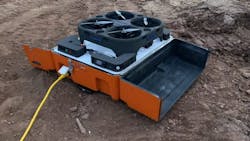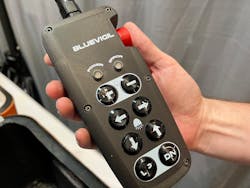Blue Vigil aims to change construction lighting
The terms “game changer,” “transformational,” and “disruptive” regarding new products are thrown around so often they seem to lack meaning.
But at Conexpo 2023, in a small, unassuming booth, was something that may trigger one or more of those adjectives. Particularly in the light tower game.
Blue Vigil is a company that is working to introduce the ALED (Autonomous LED) to the construction industry. The ALED is a portable aerial light featuring a high-intensity array held in position by a tethered drone.
It is 1/10th of the size and weight of a light tower, according to the company, and precise placement allows it to be closer to the work yet high enough (40 to 100 feet) to eliminate the issues of glare and shadow for motorists, pedestrians, and nearby homes.
That’s not all it eliminates. There is no towing. For the environmentally conscious, the ALED can be paired with wind or solar solutions for greener, quieter operation. Conventional power sources work, too, such as portable generators, vehicle inverters, and on-the-ground power.
Flight time is unlimited when connected to a power source.
Blue Vigil's onsite power source
The power source, via tether, is how everything started, explained Blue Vigil CEO Rob Schumann.
“Blue Vigil is a company that has made power tethers for years to go to M300 and CGI drones primarily for public safety—surveillance, parades—anywhere you wanted an eye in the sky all day long,” he said.
Schumann and his team eventually wondered about other uses, and if lights could be put on a drone. Then came the research and realization that the light tower industry is a big money-maker, but also an extremely mature one.
See also: When to buy, when to rent light towers
“[Outside of bulbs,] light tower technology hasn’t changed in 40 years, for all practical purposes,” Schumann said. “It’s pretty much maxed; they can’t really put the masts any higher because it becomes an exponential problem. The higher you go, the bigger the footprint you have, and it just explodes in weight and the lights are really too bright. They’ve lied to you [on brightness and projection]."
Schumann contended that when you drive through a construction site at night, you can be blinded depending on the angle of the light. “And the problem with balloon lights is that although it’s nice, diffused light, it’s actually a pretty small light field, because most of the light energy gets lost in the diffusion process. It’s also not as controlled,” he said.
The ALED produces half the lumens of a current light tower, Schumann said, “But we put twice the usable light on the ground because we’re not lighting up trees 500 yards away or shining in people’s windows.”
The entire system is in a 75-pound kit on wheels that can be moved by one person, including drone, tether, and remote control, and has been developed from day one to be a construction product.
“Building a drone, building something for construction, is a very different world,” Schumann said. "You hand a piece of equipment to a rental company and it’s not going to be treated well."
It is built to be solid, and the boxes containing the systems are built to be stacked. The drone and the entire system were custom designed, Schumann said. Multiple systems can fit in a pickup bed.
“Our drone is not designed for weight, which most drones are because it’s all about battery life. We don’t have that problem; we designed it for robustness and it’s actually made out of foam,” Schumann said. "It’s lightweight, it bends and shifts a little bit, so if it comes down and doesn’t land exactly right, you’re not damaging anything.”
The drone and array weigh about 11 pounds.
See also: Why use LEDs in light towers
As of Conexpo, the company had produced a number of prototypes. In early summer, they will put 12 pilot systems out in the field with paying customers. Eight are spoken for, with major general contractors and a smaller rental firm among the first users. Schumann pointed out that interest was high in Las Vegas.
“Right now, we’re funded by a small group of angel investors, but we’re looking at larger angels, and we’ve actually been approached now by several quite large corporations,” Schumann said.
Blue Vigil is currently accepting preorders on its website and estimates general availability by the end of 2023. Schumann estimates the system will cost around $25,000.
About the Author
Frank Raczon
Raczon’s writing career spans nearly 25 years, including magazine publishing and public relations work with some of the industry’s major equipment manufacturers. He has won numerous awards in his career, including nods from the Construction Writers Association, the Association of Equipment Manufacturers, and BtoB magazine. He is responsible for the magazine's Buying Files.


